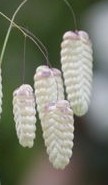 Native to the Mediterranean area, this annual grass has naturalized in many other parts of the world including western US. It has many common names including blowfly grass, rattlesnake grass, pearl grass, and shell grass. The plant forms dense clumps of pale green leaves eight inches long, and has loosely arranged oval clusters of tiny delicate flowers that hang from fine thread-like stems. Each stem has about ten flower-clusters, each .4 to .8” long. The flowers are produced from spring until late summer and are green when they first appear but become medium green and then straw colored as they mature. Although cultivated in some areas, quaking grass is considered a weed in others. Plants self sow. Excellent for dried arrangement. The genus name, Briza, is the Greek name for one of the food grains, possibly rye. The specific epithet, maxima, is the Latin word meaning very large and refers to the flowerheads.
Native to the Mediterranean area, this annual grass has naturalized in many other parts of the world including western US. It has many common names including blowfly grass, rattlesnake grass, pearl grass, and shell grass. The plant forms dense clumps of pale green leaves eight inches long, and has loosely arranged oval clusters of tiny delicate flowers that hang from fine thread-like stems. Each stem has about ten flower-clusters, each .4 to .8” long. The flowers are produced from spring until late summer and are green when they first appear but become medium green and then straw colored as they mature. Although cultivated in some areas, quaking grass is considered a weed in others. Plants self sow. Excellent for dried arrangement. The genus name, Briza, is the Greek name for one of the food grains, possibly rye. The specific epithet, maxima, is the Latin word meaning very large and refers to the flowerheads.
Type: Annual grass
Bloom: Tiny green flowers are produced from spring to late summer in oval clusters .4 to .8 inches long
Size: 12” H x 10” W
Light: Full sun
Soil: Fertile, moist, well-drained soil; tolerates less
Hardiness: Annual
Care: Low maintenance
Pests and Diseases: none of significance
Propagation: Seed
Companion plants: Pinks (Dianthus spp), African daisy, dwarf balloon flower, other grasses